Our skin can lose moisture for many reasons, and applying lotions doesn’t always help relieve the problem. However, we can turn to essential oils to help! Here are the best essential oils for dry skin.
Trying to soothe and rehydrate dry skin (especially in the winter) can feel like an uphill battle. I’ve tried a lot of things to help with itchy, peeling skin, and nothing has worked as well as these essential oils for dry skin.
Here’s what you need to know about nourishing this type of skin and which oils I recommend (and why).
Erika Bragdon is a Certified Essential Oil Coach from the Essential Oil Institute
Which Essential Oils For Dry Skin Work Best?
Does your skin tend to look flaky or rough? Does it sometimes feel itchy? Do you deal with eczema? You may have fine lines or even cracks that accentuate the appearance of aging, particularly on your face.
These are all signs of dry skin. And it can occur on your face, arms, legs, or anywhere else on your body.
Thankfully, there are many great essential oils for dry skin that work to hydrate and soothe irritated skin naturally. Find out more about each of these effective essential oils, plus how to get the best results in this post.
You can use any of these essential oils individually or mix multiple oils together to make a blend.
Please read my Common Sense essential oil safety post before using essential oils.
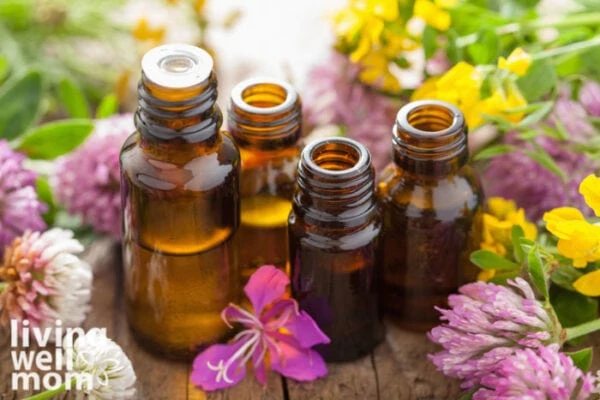
1. Lavender Essential Oil
Latin name: Lavandula angustifolia
Lavender essential oil is one of the most popular essential oils for dry skin, and for good reason. It has many benefits for skin health, helps relieve all types of inflammation and irritation, and can help support healing.
This is definitely one of the best essential oils for skin that needs calming, like itchy skin or even bug bites. Lavender oil is particularly useful for skin issues, including:
- inflammation
- roughness
- dryness
- irritated skin
- eczema
- may help reduce scarring
Safety: This oil is generally considered to be safe and well-accepted.
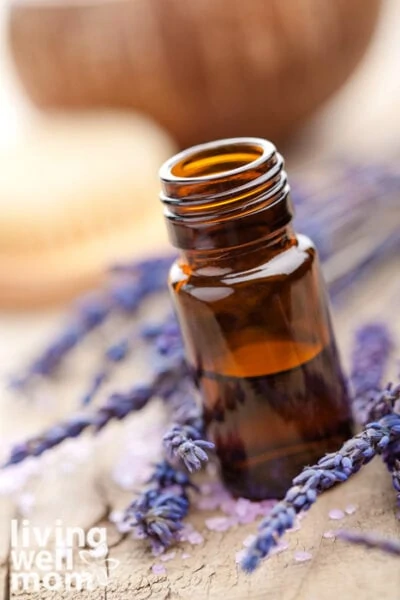
2. Helichrysum Essential Oil
Latin name: Helichrysum italicum
Helichrysum is one of my all-time favorites. My previously dry skin has been so much healthier since I started using helichrysum essential oil.
I waited to buy it for some time because it’s one of the more expensive essential oils, but when I finally did, I was amazed at how beneficial it is!
Helichrysum is known for its potential anti-aging and scar-reducing benefits because it is very hydrating for the skin. There’s also the potential benefit of helping block UV damage to the skin from sun exposure.
While Helichrysum is one of the more expensive essential oils, when compared to the many pricey creams and serums on the market, it can actually be less expensive. This is especially true when you consider how long one bottle of this essential oil can last. Plus, it’s all-natural, so that’s even better!
By the way, I bought my Helichrysum from Eden’s Garden as it’s much more affordable than many of the other brands. But it still offers high-quality products with third-party testing for quality control.

Safety: This oil is generally considered to be safe and well-accepted.
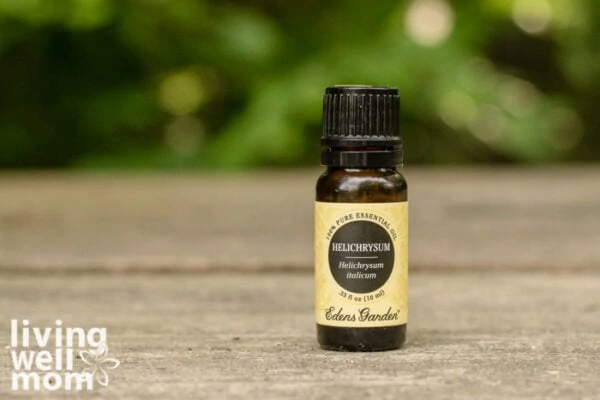
3. Myrrh Essential Oil
Latin name: Commiphora myrrha
Myrrh is another wonderful essential oil for dry skin because it both protects and soothes. It has strong antioxidant properties and may help protect against UV damage while reducing fine lines and wrinkles and supporting youthful skin.
Safety: Do not use this oil if you are pregnant or nursing. Otherwise, this oil is generally considered to be safe and well-accepted.

4. Frankincense Essential Oil
Latin name: Boswellia sacra
Frankincense has wonderful potential for minimizing scars, wrinkles, and fine lines while supporting new skin regeneration. It’s very calming and can help reduce inflammation while evening out skin tone.
Safety: This oil is prone to oxidation issues which means you should keep the bottle tightly capped and stored in a cool, dark location to help preserve it. Otherwise, this oil is generally considered safe and well-accepted.
Note: Some people have said that using frankincense oil may thin blood. My body doesn’t produce enough clotting factors, and I am more prone to bleeding excessively. However, I personally use Frankincense essential oil all the time without any negative side effects. If you have concerns, please chat with your doctor.
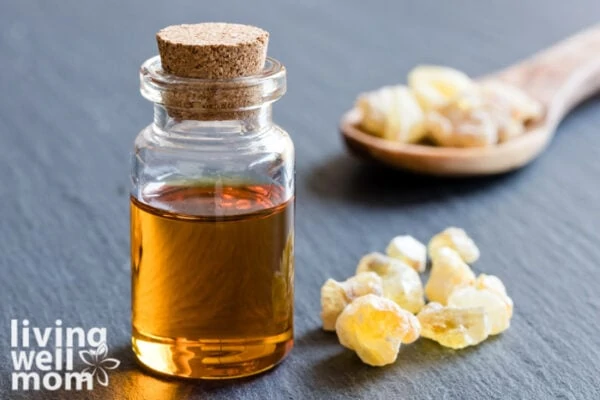
5. Geranium Essential Oil
Latin name: Daucus carota
Geranium is wonderful for balancing out dry or oily skin. It’s also helpful for moisturizing and promoting youthful skin. This oil also has natural astringent-like properties, which means it may help minimize wrinkles and fine lines and regenerate skin.
Plus, geranium oil’s anti-inflammatory properties may help minimize red, dry, irritated skin as well.
Safety: This oil has a very low risk of skin sensitization and is generally considered to be safe and well-accepted.
6. Carrot Seed Essential Oil
Latin name: Daucus carota
Carrot seed essential oil is another one of my favorite essential oils for dry skin. Its antioxidant properties can help protect the skin while also soothing it. Plus, it has a natural tint that gives the skin a healthy glow.
Safety: Do not use this oil if you are pregnant or nursing. (This is based on the conservative research of Tisserand and Young in their Essential Oil SAfety Book.)
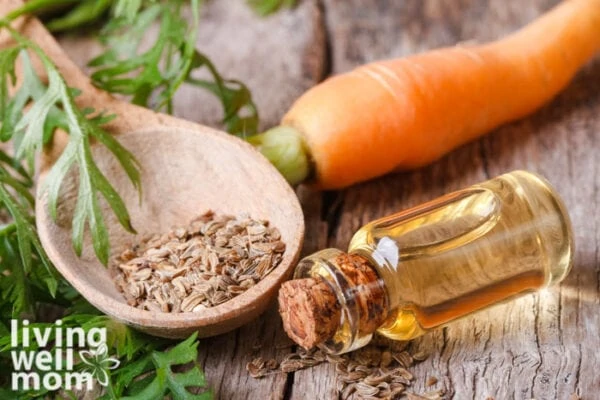
7. Cucumber Seed Essential Oil
Latin name: Cucumis sativus
Cucumber seed oil is hydrating and may help reduce fine lines and wrinkles. This oil is reminiscent of all those cucumber-scented things that were popular years ago. To me, it smells like a spa in a bottle!
8. Sandalwood Essential Oil
Latin name: Santalum paniculatum
Sandalwood essential oil is great for dry skin as it helps tone and reduces inflammation while also hydrating and soothing the skin.
Safety – Indian, Hawaiian, and Australian Sandalwood types are generally considered to be safe and well-accepted.
However, East Indian Sandalwood has a low risk of skin sensitization (irritation or reactions after repeated exposure). For the safest results, do not dilute less than 2% or about 4 drops to every 2 tsp carrier oil.
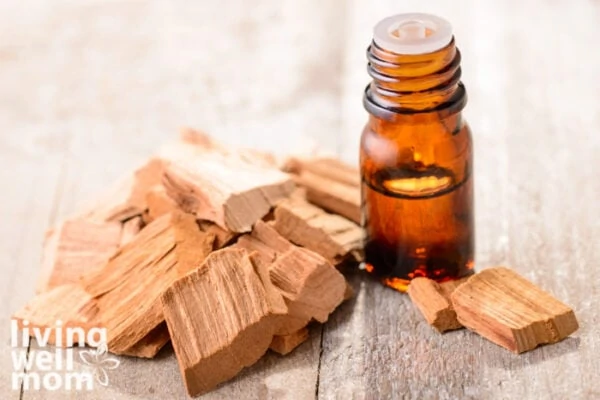
9. Ylang Ylang Essential Oil
Latin name: Cananga odorata
Ylang Ylang essential oil may help reduce signs of aging. It’s also very hydrating. This oil has a wonderful floral scent, making it one of my favorites!
Safety: Do not use topically on children under age 2. There is a moderate risk for skin sensitization (irritation or reactions after repeated exposure) that may occur with the use of this essential oil.
For the safest results, do not dilute less than 1% or about 3 drops to every 2 tsp carrier oil.
10. Manuka Essential Oil
Latin name: Leptospermum scoparium
Not to be confused with Manuka honey, Manuka essential oil is helpful for healing damaged skin, including wrinkles and fine lines, as well as reducing scarring. It may also help with the growth and regeneration of new skin cells.
Safety: This oil is generally considered to be safe and well-accepted.
11. Jasmine Essential Oil
Latin name: Jasminum sambac
Jasmine is excellent for calming irritated, dry skin due to its antibacterial and anti-viral properties. It may also help promote youthful, radiant skin.
Safety: Always dilute as there is a moderate risk for skin sensitization (irritation or reactions after repeated exposure) that may occur with this essential oil.
For the safest results, do not dilute less than 0.7% or about 1 drop to every 2 tsp of carrier oil.
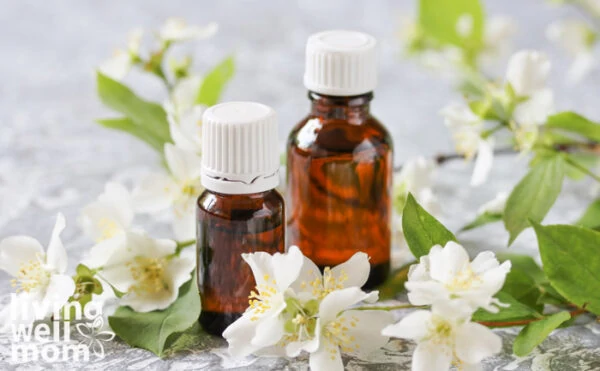
12. Hyssop Essential Oil
Latin name: Hyssopus officinalis
Hyssop is helpful for reducing scars, wrinkles, and fine lines and healing skin.
Safety – There are two main types of Hyssop (both with the same Latin name) – one type has a primary chemical compound called Linalool and is generally well accepted and safe.
The other type of Hyssop has a primary compound called Pinocamphene and should not be used if you are pregnant, nursing, or for children under 2 years of age.
For the safest results, do not dilute this type less than 0.5% or about 1 drop to every 2 tsp carrier oil.
Not sure what type your Hyssop is? Check the GCMS report for that essential oil to find out.

Family Essential Oil Handbook ↓
How To Use Essential Oils For Dry Skin
Because essential oils are so potent and powerful, it’s best to dilute them with carrier oils, which also has the benefit of helping the oils soak into the skin.
You’ll want to use 2-3 drops of any of these essential oils diluted into a carrier oil. Please take note of remarks I made under the specific oils if the dilution ratio needs to be altered from this amount.
If you want to use ALL of the essential oils listed in this post, I’d recommend mixing up a small one or two-ounce glass bottle with a combination of carrier oils and adding 5 or so drops of each essential oil for the best results.
Note: You can also mix these essential oils into your favorite lotion!
Carrier Oils For Dry Skin
The most common carrier oil is fractionated coconut oil. However, I recommend one or more of the following carrier oils when using essential oils. This is because these carrier oils are more hydrating and moisturizing than fractionated coconut oil.
My favorite carrier oils for dry skin are:
I use a combination of the five above carrier oils for my dry skincare routine, though my two favorites are Jojoba and Argan oil.
Other carrier oil options include grapeseed oil, avocado oil, and olive oil.
There are so many ways you can use these essential oils for dry skin! If you are looking for an easy recipe to start with, I highly recommend this DIY cuticle oil. Your nails will thank you.
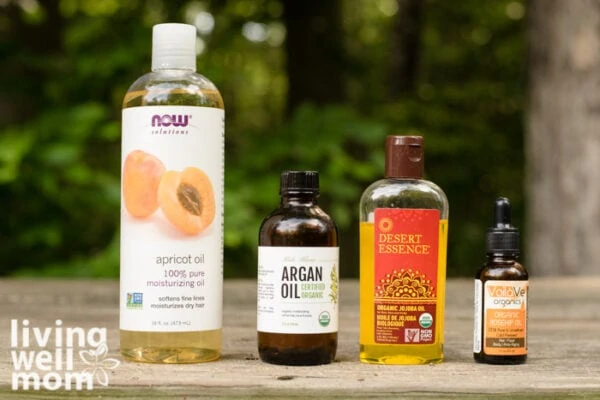
Which Essential Oil Brand is the Best?
For the best results, you will want to choose a high-quality essential oil brand that is 100% pure and offers third-party testing for quality control.
My favorite essential oil company is Rocky Mountain Oils, followed by Eden’s Garden and Ancient Apothecary by Dr. Axe.
You can find those oils here:
- Rocky Mountain Oils – get free shipping on any order
- Eden’s Garden – get free shipping on any order
- Ancient Apothecary by Dr. Axe – you can order directly from his website or through Amazon
Safety Note Regarding Essential Oils For Dry Skin
If you have any underlying conditions, such as eczema, psoriasis, or rosacea, check with your dermatologist or doctor before using essential oils.
Essential Oils For Dry Skin FAQs
After reading this information, people typically have a few questions. Here are the most common questions I see.
If you have a question but don’t see it answered below, please leave it in the comments!
Do essential oils hydrate skin?
Yes, and the combination of essential oils and moisturizing carrier oils is a powerful 1-2 punch for dry skin. There are essential oils that benefit many skin conditions and are ideal for every skin type.
It may sound counterintuitive, but water dries out the skin. If it’s winter or you wash your hands or face often, you need to replace the lost moisture. Thirsty skin soaks up essential oils at a deeper level than just the top layer.
Which essential oil is best for dry skin?
Any of the oils on this list are hydrating and beneficial. But the ones that I seem to turn to again and again are helichrysum, ylang ylang, frankincense, and lavender essential oil.
What oils can I mix for dry skin?
You can feel confident in using any of the oils on this list. Or feel free to mix and match any combination of them based on skin needs and the aromas you prefer.
Always dilute essential oils with a carrier oil before using them. This is because essential oils are very potent, and a little goes a very long way. Plus, they help the essential oils penetrate deeper into the skin.
How do you hydrate your face with oil?
Create a carrier oil and essential oil blend based on the skin conditions your face is experiencing. As an added bonus, by keeping your face hydrated with natural essential oils, you may even notice some anti-aging benefits.

My Results Using Essential Oils For Dry Skin
Since I began using a combination of these essential oils and carrier oils a few years ago, my face is noticeably softer and smoother, and my forehead lines are much less noticeable. I rarely need to wear foundation now because my skin feels and looks great without makeup!
All I did was simply mix and match the 12 essential oils mentioned in this post, along with the carrier oils.
I hope you’ve found this post helpful! Let me know how these oils work for you and which ones are your favorites in the comments below.
More Ways To Use Essential Oils For Skin
- Natural Homemade Foaming Face Wash
- How To Make A Cream For Cracked Heels
- Nourishing DIY Cuticle Oil
- Homemade Coconut Oil Lotion Bars
- DIY Facial Toner Pads
Want to save all this information for later? Pin the image below to your essential oil board on Pinterest!
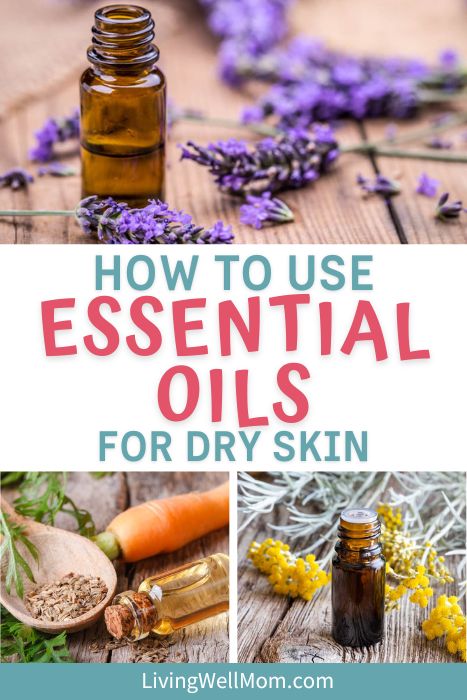
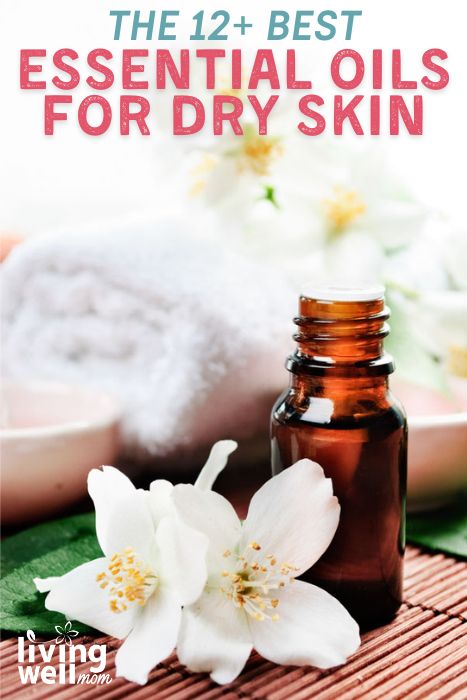
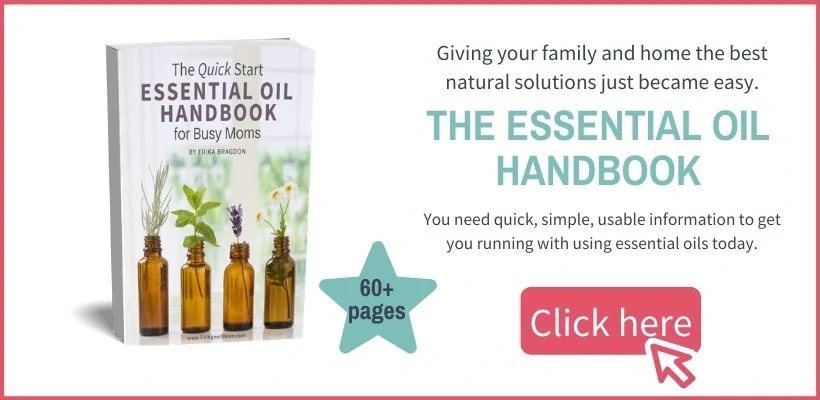
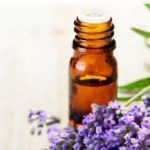


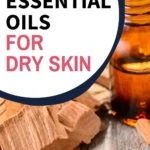
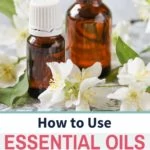
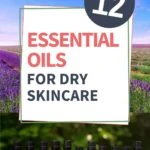
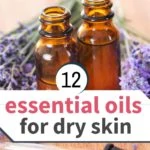
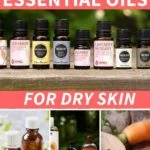

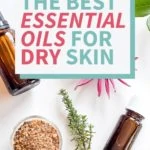


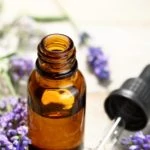
sofia wilson says
Hi, Erika, I guess you forget to add another 🙂 Don’t know if you’re ever using or not but tamanu oil is another great option when it comes to treating dry skin.
IVY TETTEH- MENS says
thanks a lot for the information ,Am a Ghanaian and i have a very dry skin and its very difficult for me to get a good moisturiser for boyh my face and body.Kindly recommend a mixture of oils for me.Ican get apricot by Now Organics in ghana .
best regards Ivy
Eliza says
Can I use cedarwood oil for treating eczema can you guide me? or write a brief article on it. Thanks.
Julia Stearns @ Healthirony says
I get my massages every week; I do feel better. And of course, I use different essential oils like lavender and lemon! Thanks for sharing, Erika
Mary says
I love how simple this list of essential oils for dry skin is. This is a really good idea that looks like something I could even do.
Paris says
Good day, i know you talked about combining the 12 essential oils for a dry skin mix, but what combination did you use if not all of them that has helped you to reduce dry skin, bring on plumping and reduced fine lines? Also, do you use this every day, every morning? My skin is very dry and always has been. I have used lotions for all of my life and realized this is not good for my skin and since then have stopped. But now I cannot get my skin to respond to the essential oils I am currently using, which is mainly coconut oil. I also don’t truly understand the carrier oil vs. the essential. I have a lot of research to do.
Erika says
I mix up a small 1 or 2 oz glass dropper bottle with 1-2 drops of each essential oil listed here (you can mix and match though) and fill the rest with argan oil. Then I rub it on my face each night before bedtime. It works very well and is so easy to make.
Sammie L says
Geranium oil is my favorite and I use it (nearly) every day on my skin. I just put some carrier oil in a bowl, add 3-5 drops of oil, then massage into my body after a shower. It’s a great way to start the day. I’m keen to try a couple of others on this list too that – Cucumber Seed and Manuka.
Moksha Essentials says
Thanks For Sharing Your Content and Designs. Keep Doing Good Work.
Scarlet says
I love essential oils and I always have dry skin so thanks for the sharing the best ones to use as a natural remedy!
Erika says
Sand is a great idea – cheap and easy too!
Moksha Lifestyle says
Great Article… I love to read your articles because your writing style is too good, it is very very helpful for all of us….
Continue to share useful resources over these blogs…
Megan says
Oh, dear, I wish you had said in the article that it’s specifically “helichrysum italicum” — I already bought the wrong one and sent it to a friend for dry skin issues. Eden’s Garden didn’t differentiate and when I searched helichrysum, I ended up buying the one that’s used for congestion and won’t help with skin at all.
Erika says
Sorry, Megan. I shared a link to the helichrysum italicum but I will make sure to include the scientific name specifically next time. http://bit.ly/2xF1veI
Michelle Lemelle DeView says
I have tried 3 times to get the free gift. It says that it is on its way but always stops at 75% sent. I even tried putting in a different email address but same thing happened. Any suggestions would be appreciated 🙂
Thank you,
Shellie
Erika says
Hi Michelle, did you check your spam filter? Sometimes the email gets lost there. Look for an email from erika@livingwellmom.com
I see your email in my system but it was not confirmed yet. Feel free to email me (same email as above) if you still need help.